AUCTORES
Globalize your Research
Case Report | DOI: https://doi.org/10.31579/2692-9562/119
Family Physician & Public Health Consultant Bengaluru, India,
*Corresponding Author: Suresh Kishanrao, Family Physician & Public Health Consultant Bengaluru, India,
Citation: Suresh K, (2024), Chronic Sore Throat in Adults - A Challenge! To Primary Care Providers and Otolaryngologists Too!!, Journal of Clinical Otorhinolaryngology, 6(3); DOI:10.31579/2692-9562/119
Copyright: © 2024, Suresh K. This is an open access article distributed under the Creative Commons Attribution License, which permits unrestricted use, distribution, and reproduction in any medium, provided the original work is properly cited
Received: 22 March 2024 | Accepted: 04 April 2024 | Published: 08 April 2024
Keywords: chronic sore throat; etiology; chronic tonsillopharyngitis; gastroesophageal reflux; laryngopharyngeal reflux
Background: Sore throat, medically called "pharyngitis" is an inflammation or infection of the lymphoid tissues of the posterior pharynx and lateral pharyngeal bands. Acute sore throats among children are one of the most common health conditions that primary health care physicians deal with. It usually resolves on its own without complications in adults. Some adults tend to be more prone to developing frequent infections, basically due to developing fewer antibodies and a less robust immune response in each infection resulting in ‘Chronic Sore Throat’, the subject of this article. Chronic sore throat is to an otolaryngologist, as headache is to neurologist, often seemingly trivial symptom but heavily demanding for bringing relief. The symptoms of chronic sore throat include painful swallowing, scratchy or hot, burning sensation, lancinating pain, a sort of “raw” feeling, and or deep boring pain that worsens with mastication, swallowing and talking. The pain often radiates to the ears and temporo-mandibular joints, aggravating its intensity. Each year, pharyngitis is responsible for more than 40 million visits to health care providers as most children and adults experience 3-5 and 1-2 upper respiratory infection every year and half of the episode may lead to seeking care from primary care physicians or ENT specialists. As with common cold, viral pathogens in pharyngitis appear to invade the mucosal cells of the nasopharynx and oral cavity, resulting in edema and hyperemia of the mucous membranes and tonsils and sometimes even adenoid glands. The etiology of pharyngitis can be either viral, Bacterial, fungal infections or noninfectious origin such as smoking, environmental pollution, and allergic reactions to pollen, mold and pet dander, Laryngopharyngeal reflux (LPR), and rarely throat cancer.
Materials and Methods: This article is based on the experience of managing an adult female patient with Chronic Pharyngitis, second time in last 4 years just on Sunday the 17 March 2024. Diagnosed based on Clinical judgement differentiating between bacterial and viral infections and using Centor Score a Clinical prediction scale. Following this the literature search helped to complete the article.
Results: A physical examination of the throat under a beam of light, recording temperature and auscultating chest. Based on her previous episode in 2020, she was treated with Inj. Benzathine Penicillin 1.2 million IU and Local southerners like warm water gargles and drinking warm milk with Turmeric. She felt better by the next morning and has recovered fully by 21 March 2024.
Conclusions:Chronic Pharyngitis in adults is not rare among adults, mostly viral but rarely lingering Streptococci infection. Clinical judgement in differentiating between bacterial and viral infections, symptomatic treatment with NSAIDs and local antibiotic and or analgesic lozenges and use of antibiotics only if bacterial infection is suspected, must be the guidelines to be followed.
URI= Upper Respiratory Infections, LRI= Lower Respiratory Infections, NSAIDs= Nonsteroidal anti-inflammatory drugs, HIV/AIDS= Human Immunodeficiency Virus, Acquired Immunodeficiency Syndrome, RMPs= Registered medical practitioners,
The medical term for a sore throat is "pharyngitis." It usually resolves on its own without complications in adults. Pharyngitis is an inflammation of the pharynx involving lymphoid tissues of the posterior pharynx and lateral pharyngeal bands [1]. Each year, pharyngitis is responsible for more than 40 million visits to health care providers. Most children and adults experience 3-5 viral upper respiratory tract infections, including pharyngitis which forms at least 50% of them per year.
Acute Sore throats: Acute sore throats among children are one of the most common health conditions that primary health care physicians deal with. Bacterial sore throats comprise of only 5–15% of sore throat cases, though antibiotic prescription is common in almost all the sore throat cases. Group A beta-hemolytic streptococcus or Streptococcus pyogenes is the most important bacterial agent associated with acute pharyngitis and tonsillitis. Similarly, Corynebacterium diphtheriae causes occasional cases of acute pharyngitis, as do mixed anaerobic infections (Vincent's angina), Corynebacterium hemolytic, Neisseria gonorrhoeae, and Chlamydia trachomatis. Approximately 50-80% of pharyngitis symptoms are caused by a variety of viral pathogens, common among them are Respiratory Syncytial Virus (RSV), Para-Influenza Virus- (PIV), SARS COV 2 (Covid 19), Human Rhino Virus (HRV), Human Metapneumo virus (hMPV), and Influenza virus and accompany a common cold or influenza. However, the etiology can be either viral, Bacterial, or even fungal infections as well as noninfectious etiologies such as smoking, environmental pollution, and allergic reactions to pollen, mold and pet dander, Laryngopharyngeal reflux (LPR), and rarely throat cancer can result in chronic pharyngitis [2]. 2020-2022 witnessed under reporting of Sore
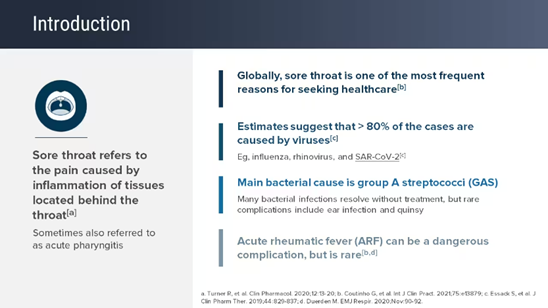
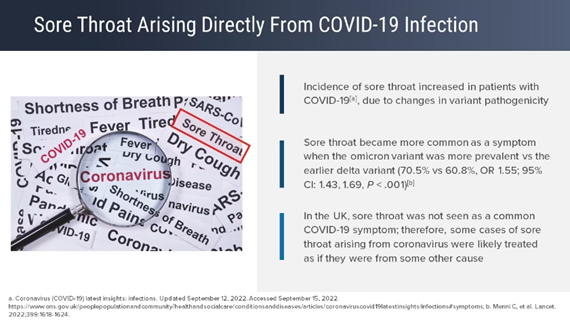
throat due to Covid 19 set and there after the incidence has again started rising mainly due to lifting restrictions and people not following respiratory hygiene. In 2023 H3N2 Virus infection led to respiratory infections, with fever, sore throat, persistent cough, headache, confirmed by ICMR’s Pan India Respiratory surveillance through 30 viral Research Laboratories in India [3]. This is not the topic of discussion for this article.

Chronic sore throat is to an otolaryngologist, as headache is to neurologist, often seemingly trivial symptom but heavily demanding for bringing relief. Often used irreversibly with odynophagia, the symptom of chronic sore throat includes painful swallowing, scratchy or hot, burning sensation, lancinating (piercing or stabbing) pain, a sort of “raw” feeling, and deep boring pain that worsens with mastication, swallowing and talking. The pain often radiates to the ears and temporomandibular joints, aggravating its intensity [4,5]. This article is based on managing such a case with both oral Penicillin in the past and with Benzathine Penicillin 1.2 million units last week and literature search about the global and Indian current Practices.

On Sunday 17 March 2024 late evening (2030 hrs.) Ms. Divya, in her early 30’s called complaining of sore throat, scratchy sensation, tolerable but piercing pain, mild fever, and deep boring pain that worsened with mastication, swallowing & talking. She had a similar episode in early 2020. A working lady managing office work, household chores, a school going son’s homework etc. and demanding in-laws, keeps her most often under stress. On physical examination her throat showed a little inflammation on the posterior side, Tonsils were almost normal, her voice was bit hoarse, body temperature was 390 C, indicative of chronic inflammation. Knowing her history, clinically diagnosed it as Chronic Pharyngo-tonsillitis and gave her an injection of Benzathine Penicillin 1.2 million units, after a test dose. Asked her to do saltwater gargles and drink Turmeric added Milk before going to bed. The first such episode she had in early 2020 and at that time was treated with Penicillin G Oral tablets for about a week with marginal benefit, then an injection Benzathine Penicillin 1.2 million units was given, which had given a remission till this episode of nearly 4 years. Her throat pain reduced by about half by the next morning. Despite mild fever’s persistence, she had to attend the office the next day after taking care of her morning household chores. By afternoon she was not having fever also. By late evening on Monday, she was almost normal with neither fever nor throat pain, except a bit of weakness. As on Wednesday 20 March 2000 hrs. she confirmed over the phone to be almost normal.
Sore Throat (Pharyngitis) is a common upper respiratory inflammation or infection that usually goes away after a few days. But when the soreness lingers or comes back frequently, it’s called chronic pharyngitis. Acute pharyngitis is more common than chronic pharyngitis. The best recommended management involves treating the symptoms, as it usually subsides within 10 days. Antibiotics are recommended only if bacterial infection is suspected.
Chronic & Recurrent Infections: Chronic and recurrent tonsillitis is a condition that causes swelling of the pharyngeal tonsils and back of the throat and sometimes even the adenoids and the lingual tonsils are also inflamed or infected. The true recurring strep throat means an individual must experience multiple infections during a single respiratory season. Recurring strep throat infections are treated the same way as a primary infection but responds better to long acting Benzathine Penicillin Injections and oral penicillin tablets.
Chronic sore throat, alternatively referred to as “chronic pharyngitis” by otolaryngologists, connotes a recalcitrant medical condition that often defies all possible forms of management. Approximately 30% of patients with chronic pharyngitis have no identifiable cause. “Inflammation of the pharyngeal mucosa and/or the sensation of burning or pricking sensation in the throat that has persists for more than 10 days despite medication” is a working definition one can use. The symptoms of chronic sore throat include painful swallowing, scratchy or hot throat, or a sort of “raw” feeling, burning sensation, lancinating pain, and the typical deep boring pain that worsens with mastication, swallowing and talking. The pain often radiates to the ears and temporo-mandibular joints, aggravating its intensity [7]. Some other specialists use the definition Chronic Pharyngo-tonsillitis if an individual suffers from one or more attacks of Pharyngo-tonsillitis per year or less frequently (once in 2-4 years as the immunity wanes) and the symptoms linger for longer than 10 days.
Risk Factors: Some people tend to be more prone to developing frequent infections, basically due to developing fewer antibodies and a less robust immune response to each infection. People who have any underlying condition that weakens the immune system, are at higher risk of such recurrence. Immune system becomes a poor responder if the person is under a great deal of stress, regularly taking a corticosteroid for any medical condition, suffering from illness such as HIV or AIDS, taking immunosuppressive drugs after an organ transplant and chemotherapy for cancer treatment and aging, as our immune system becomes less effective with advancing age. Antibiotic resistance following an inadequate dose, or not completing a full course of antibiotic treatment is common in India. Resistance develops as some patients with strep infection stop taking antibiotics once they start feeling better rather than finishing the entire course. This type of inadequate treatment will be less effective in completely eradicating the infection and leads to Chronic Sore throat. Sometimes even a doctor especially RMPs or quacks in India do not prescribe a strong enough dose to eradicate the bacteria. Either way, the persons keep experiencing relapses over years [8].
Carriers of strep throat bacteria: Some people carry strep bacteria without symptoms. Frequent regular strep throat indicates frequent contact with someone who is a strep carrier, and repeated exposure to the bacteria is infecting [8]. Our case belongs to this group.
Genetic predisposition: A 2019 study reported that many children who had their tonsils removed due to recurrent tonsillitis had a family history of recurrent tonsillitis.
Etiology: Approximately 50-80% of pharyngitis symptoms are caused by a variety of viral pathogens, common among them are Respiratory Syncytial Virus (RSV), Para-Influenza Virus- (PIV), SARS COV 2 (Covid 19), Human Rhino Virus (HRV), Human Metapontum virus (hMPV), and Influenza virus and accompany a common cold or influenza. However, the etiology can be either viral, Bacterial, or even fungal infections as well as noninfectious etiologies such as smoking, environmental pollution, and allergic reactions to pollen, mold and pet dander, Laryngopharyngeal reflux (LPR), and rarely throat cancer can result in chronic pharyngitis [2]
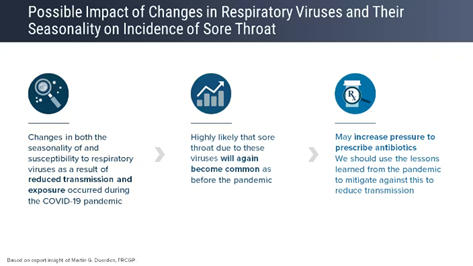
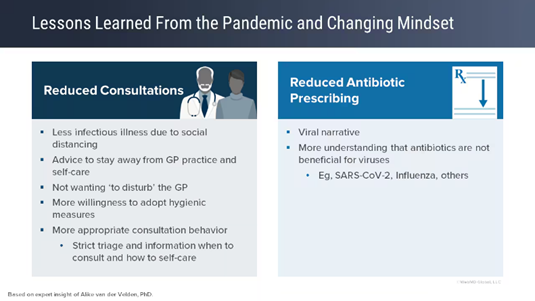
Pathogenesis: As with common cold, viral pathogens in pharyngitis appear to invade the mucosal cells of the nasopharynx and oral cavity, resulting in edema and hyperemia of the mucous membranes and tonsils. Bacteria attach to and result in super-infection. In the case of group A beta-hemolytic streptococci, they invade the mucosa of the upper respiratory tract. While many clinical manifestations of infection appear to be due to the immune reaction to products of the bacterial cell, in diphtheria, a potent bacterial exotoxin causes local inflammation and cell necrosis. Chronic pharyngitis symptoms are like acute pharyngitis symptoms but a bit milder. Common signs include Pain or scratchiness in your throat, Swollen glands in your neck, Hoarseness, Difficulty in swallowing, A tickling sensation in the throat, A tired voice, A sensation that something is stuck in the throat as was complained by our case. If there is an infection over a sore throat the patient develops Fever, Headaches, Coughing, Sneezing. Nausea and vomiting. Chronic tonsillitis tends to have ongoing Sore throat, enlarged tonsils, bad breath, which may be related to cryptic tonsils- pockets in the tonsils where food and debris can accumulate and enlarged and tender neck lymph nodes.Chronic pharyngitis is contagious if it is due to a viral or bacterial infection, and it can be transmitted from one person to another through saliva, mucus, and nasal discharge. Some viruses and bacteria can survive on surfaces for a period, so contact with towels, toothbrushes, clothing or eating utensils can spread the disease [3].
Viral pharyngitis is contagious for the entire period of symptoms presence and antibiotics are not effective. If it is bacterial pharyngitis, a course of antibiotics reduces the length of time of contagiousness to 24 hours of taking an effective antibiotic.

Diagnosis and Tests: A. Clinical judgement is the best for differentiating between bacterial and viral infections. Clinicla prediction scales can also be used. A physical examination includes inspection of the throat under a beam of light, recording temperature and auscultating for LRI if any. Recently three clinical scoring systems have been developed for identifying red Flags for urgent referrals.1. Centor Score: use one point for each of i)
Tonsillar exudates (TE), cervical lymphadenopathy, temperature of 380C or more and No cough 2. McIsaac Score: apart from the four point this sues the age as 5th point giving +1 to age<15>45 yrs. 3. FeverPAIN Score: this scoring system uses i) elevated temperature in preceding 24 hrs. ii) TE iii) consultation in first 3 days due to severity of symptoms, iv) pronounced redness and swelling of Tonsils v) No cough or Rhinitis.

B. Laboratory examinations like CBC, Rapid antigen detection test and a throat swab culture (PCR) if it is a non- viral infection for strep throat may be advised. Rapid testing has a sensitivity of 80-85% and specificity of 90%. PCR has 100% sensitivity and specificity. This test helps in choosing appropriate antibiotics also. However, Indian situation these tests are available only in major urban localities.
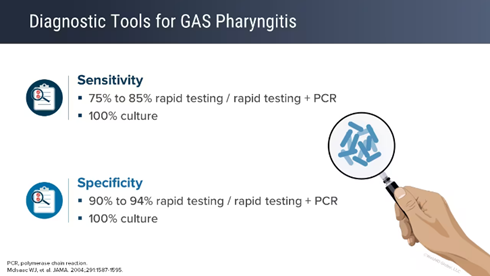
Management and Treatment: There is no single accepted, practical guideline, or a standardized and generalized algorithm on how to approach a patient presenting with chronic sore throat. The multiplicity and heterogeneity of the spectrum of etiologies of chronic sore throat make the task of enumerating them far from exhaustive. Rest, oral fluids, and salt-water gargling, Turmeric added warm milk gargling and then gulping, are the main supportive measures in patients with viral pharyngitis.

Systemic Therapy: NSAIDs- Ibuprofen or Naproxen & Paracetamol (Acetaminophen) Topical Oral Therapy: 1. NSAID Lozenges, sprays, and granules, 2, Anaesthetics and Antibiotics 3. Non medicated Lozenges- traditional gargles, motuh washes

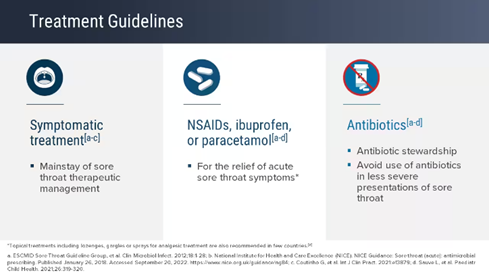
Multiple doses of flurbiprofen lozenges (Vittfen Lozenges, Flurwell 100mg Tab) provide effective relief of sore throat pain intensity as well as difficulty swallowing, a painful or swollen sore throat. Flurbiprofen is a non-steroidal anti-inflammatory drug (NSAIDs) used to relieve pain and inflammation.
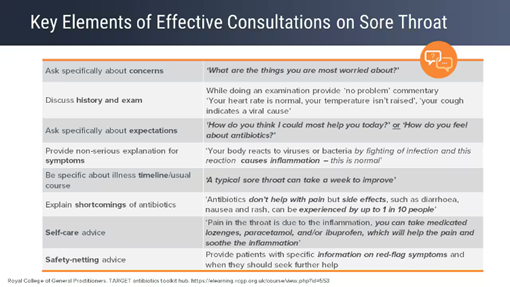
Benzocaine Lozenges (Shalusil Black Curren Lozenges, Strepsil Lozenges etc. Orac Turmeric Lozenges)
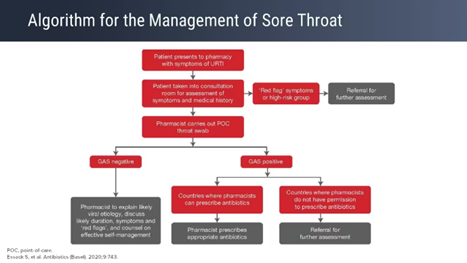

Antibiotics: Penicillin or amoxicillin is the antibiotic of choice to treat group A strep pharyngitis. There has never been a report of clinical isolation of group A strep that is resistant to penicillin. However, resistance to azithromycin and clarithromycin is common in India. Macrolides is reserved for patients allergic to penicillin. Therefore, for sore throat caused by group A streptococcus, Oral Penicillin for 10 days is the common antibiotic treatment. Alternately a single dose long acting Benzathine Penicillin Injection D-1(1.2 million units for adults and 0.6 million IU for children weighing less than 27 Kg) is advised. Due to slow absorption and hydrolysis, the concentration of the drug in the blood remains lower but for a prolonged period. After a 1.2-million-unit injection, adults have detectable drug concentrations for 14 days, often longer. Please note that only organisms that are very sensitive to penicillin will be inhibited by the low tissue concentrations achieved. The medication is excreted by renal tubular excretion.
The process of Injection: Since the drugs comes in crystalline powder, it needs to be diluted, preferably in 4-5 ml. distilled water, in contrast to procaine penicillin which is usually diluted with 2 ml. water. The Injectoion needs to be given in Deep intramuscularly in gluteal region. In view of the risk of reactions, the need for test dose every time and the difficulty in pushing the thick solution, not many practitioners give this injection these days.
Pharmacokinetics of Benzathine benzylpenicillin: Benzathine is the least soluble salt form of penicillin G, thus providing the longest duration of action. Maximum concentration is observed between 12 and 48 h after injection. Benzathine penicillin G has a long apparent half-life of approximately 336 h with drug input into blood circulation for more than 30 days following a single intramuscular injection. In contrast Penicillin G or Procaine Penicillin will be out of our system after about 7.7 hours after the last dose injection. Injection Procaine Penicillin has an elimination half-life of approximately 1.4 hours or less. 5.5 x 1.4 hours = 7.7 hours for penicillin. Procaine benzylpenicillin interferes with the synthesis of the bacterial cell wall peptidoglycan. It acts through the inhibition of biosynthesis of cell-wall peptidoglycan, rendering the cell wall osmotically unstable [10].
Prevention:
Primary care Physicians & Otorhinolaryngologist must use masks and insist the patients also wear mask, except for a minute or two pf throat examination. Avoid contact with people who are sick, Family members must not share food, beverages or eating utensils, and wash your hands frequently or use antibacterial hand sanitizer when soap and water isn’t available. When chronic pharyngitis persists despite optimum management, especially in chronic granular pharyngitis, an allergic etiology (atopy) may be found associated with rhinosinusitis a course of steroids in conjunction with long-acting antibiotics like Benzathine Penicillin and topical gargle will lead to temporary remissions. Further investigations like absolute eosinophil count, immunoglobulin E assay, skin prick test for allergens, radio-allergosorbent test (RAST) can be carried out, and subsequent prolonged antiallergic/immunomodulatory treatment with rehabilitation might lead to long-term resolution.
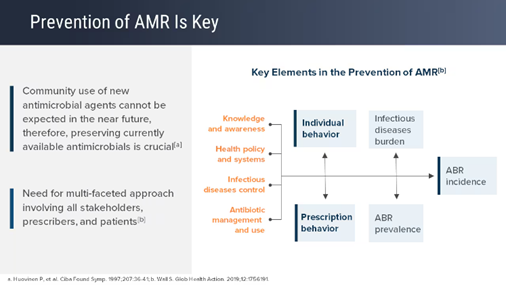
Recent studies:
Chronic Tonsillitis (CT):
Sudan Study: A cross-sectional descriptive study in June-September 2022 which screened using a structured questionnaire of 297 Patients who presented to all ENT clinics in Secondary Care Hospitals in Rabak City, Sudan. 77 patients were confirmed to be having CT based on the inclusion criteria. The prevalence of CT was 25.9 % (77) among all screened patients. The majority (67.5%) of the patients with CT were male, and remaining one third were female. While most cases were in the age group of 11-20 years (32.4%), 15 cases (20%) were in the age group of our case 31-40 yrs. One third of them (32.4%) were residing in the urban-industrial part of the city, as was our case. All the patients with CT complained of throat pain, while 88% presented with red inflamed tonsils, 67% had Fever, 65% had Jugulodigastric lymph nodes enlargement, 56% had other constitutional symptoms, and 46% had Odynophagia. Laboratory investigations of these patients revealed 64% to have Neutrophilia, while 54 and 50% had high ESR and positive ASO titer, respectively. While (30%) were managed medically 57% of the patients had to undergo tonsillectomy [9].
Kolkata, India Study: In another hospital-based descriptive study in Kolkata, India over a period of 3 years (January 2014 to December 2016). In this study 1580 patients with chronic sore throat (>12 weeks duration, despite conventional medication) were evaluated in a tertiary care teaching institute of Kolkata eastern India. A detailed history, appropriate investigations, and a self-designed algorithm were used. There was a minimal female preponderance, the female: male ratio being 1.25. About 39% of patients were chronic smokers, and 31% were addicted to alcohol. Forty-three (2.72%) patients were reactive to HIV 1/2. The study provided a detailed account of the heterogeneous etiology of chronic sore throat, and an overall structured idea on how to approach its work-up and diagnosis. Chronic tonsillopharyngitis, gastroesophageal reflux disorder, submandibular sialadenitis, and laryngopharyngeal reflux disorder were the chief causes of chronic sore throat. Allergy, psychiatric illnesses, oral submucous fibrosis, comorbidities (diabetes mellitus, hypothyroidism, uremia, arthritides), stylalgia, Koch’s pneumonitis, recurrent aphthous ulcers, and dietary deficiencies formed the other major causes The study also developed an approach to the Chronic sore throat problem in the day-to-day clinical practice of otolaryngology and general medicine. However, since the study was chiefly population-based and considered a multiplicity of causes for chronic sore throat, the “investigation of choice” for certain ailments were out of scope for the study design [5]. Being a study that primarily aimed at delineating the oled of one of its symptoms; they relied on the patients’ history and nasopharyngolaryngoscopy findings for diagnosis. Despite some limitations like24-hr double probe pH monitoring, the gold standard for the diagnosis of laryngopharyngeal reflux disorder, the researchers believe that the study would provide a useful overview of the wide spectrum of differential diagnoses of chronic sore throat and would be helpful in a practical set-up that deals with a huge number of patients with such complaints. The study population, although large enough to predict reproducibility of the results, could have been further increased by making more representative of the prevailing economic strata of society, had it been designed as multicentric, involving the other teaching referral hospitals of the area as well as the corporate institutions. [5].
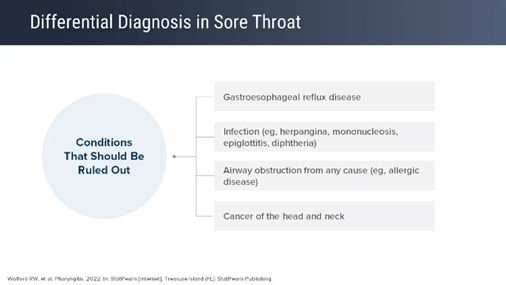
The research team of the study recommended the following Logarithmic chart for use by general practitioners and Otorhinolaryngologist, which this author has tried in about 11 patients including the one reported in this article and found it to be useful.


Source: Encountering Chronic Sore Throat: How Challenging is it for the Otolaryngologists? [5]
Haryana, India Study: A community-based survey over a two-year period, (Aug 2012 to Aug 2014) of 3765 children under 10 years followed up for 5578 child years. 1069 episodes of sore throat were reported, and swabs were collected from 8% of the cases randomly. The incidence of sore throat and viral sore throat was 191.7 and 60.1 episodes per 1000 child-years (EPTCY), respectively, indicating that nearly one third of the sore throat episode in India are viral in origin. Fever (OR 5.40,) and running nose (a OR 10.16) were significantly associated with viral sore throat. The clinical score of fever, running nose, and headache had an overall sensitivity of 86.2%, specificity of 62%, and Area under the Curve (AUC) of 0.78 in predicting viral sore throat [6]. This study adds to the information and knowledge about epidemiology of viral sore throats in India and infers that Viral sore throat contributes to a significant problem in the community and emphasizes on symptom attributes of URIs due to viral etiology. It recommends that clinical scores could be utilized in primary care settings for predicting viral URI, thereby guiding antibiotic prescription. These algorithms will be cost-effective, less time consuming and have a greater impact in aiding primary care physicians for optimal utilization of antibiotics.
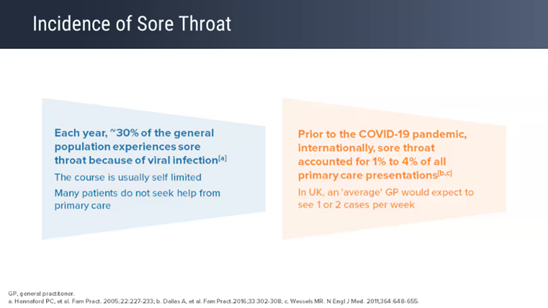

The Challenges: Chronic sore throat is to an otolaryngologist, as headache is to neurologist, often seemingly trivial symptom but heavily demanding for bringing relief. Often used irreversibly with odynophagia. Considering the extent to which the quality of life of the patients is impaired, it is often challenging for the practicing general physician and even otolaryngologists to deal with this recalcitrant, nagging problem without dismissing the symptoms as “fictitious” and “psychogenic”. But where no such cause can be established, it might be judicious to take a throat swab for aerobic culture and sensitivity. Organisms like Pseudomonas Areosa may be detected and can be treated with for about 2 months. An antibiogram with causative organism(s) promises a good prognosis. However, when there is an absence of growth at 48 h, a trial of second or third generation cephalosporins or macrolides with azoles or antifungals might produce surprising results. Another challenge is with persistence of sore throat sans clinical pharyngitis or following remission of clinically evident pharyngitis. In such situations, exploring the adjacent anatomic areas/structures for other causes becomes necessary. These include the submandibular glands (chronic sialadenitis), elongated styloid (stylalgia/Eagle syndrome). and treating them accordingly with fluoroquinolones might benefit with/without surgical excision for chronic sialadenitis, and carbamazepine/tricyclic antidepressants. Neoplasms at the base of tongue, vallecula and tonsils require special mention as they often remain hidden and need to be visualized through indirect laryngoscopy and flexible nasopharyngolaryngoscopy. Chronic laryngitis and laryngopharyngeal reflux might, rarely, give rise to this peculiar “sore throat” sensation These conditions are identifiable clinically by flexible nasopharyngolaryngoscopy from the characteristic mucosal changes, and treated subsequently after exclusion of other surgical pathologies like hiatus hernia. Dietary deficiencies, often associated with clinical pallor, cheilosis, glossitis, dysphagia, aphthous ulcers, dermatitis, and diarrhea, might also result in chronic sore throat like Plummer Wilson Syndrome can be managed by supplementation with hematinic, multivitamins with microelements like zinc, apart from treating the primary cause. Certain common systemic disorders and comorbidities causing immunosuppression can also affect the throat, like type 2 diabetes mellitus, hypothyroidism with history of subacute thyroiditis and uremia. These need to be identified promptly as the possible cause(s) or contributing factor(s) for persistence of sore throat, and respective directed treatments should be initiated at the earliest [7,9]. Patients on disease modifying antirheumatic drugs (DMARD) as in arthritides, skin ailments like pemphigoid or lichen, and connective tissue disorders, and long-term oral steroids for asthma are also prone to repeated attacks of sore throat and its persistence, along with recurrent aphthous ulcers, oral candidiasis, and xerostomia. In these patients, systemic examination of musculoskeletal, urogenital, integumentary and uveoretinal systems becomes mandatory. Infectious viruses, especially hepatitis C and human immunodeficiency virus (HIV) bring with them their own oral and oropharyngeal manifestations which might result in chronic sore throat. In India use of betel quid, tobacco as pan masala and smoking, complicated by chronic alcohol intake, might lead to oral submucous fibrosis. The condition is characterized by intense burning sensation in mouth and mucosal changes where the oral and oropharyngeal mucosa becomes smooth, atrophic, characterized by hyaline degeneration resulting in decreased elasticity, often associated with vesicles, erosion, and hyper melanosis. Abstinence from the primary cause with topical/systemic/intralesional steroids along with long-term antioxidant therapy can potentially lead to clinical remission in most patients. Besides, toxic fibro myositis following influenza (H3N2) might result in prolonged tenderness over anterior aspect of neck, especially over the greater corn of hyoid, producing pain during swallowing [3,9] as was experienced by many people in India after H3N2 outbreaks. Other relatively less common entities associated with chronic sore throat but often ignored include burning mouth syndrome and chronic fatigue syndrome, which need to be treated with antidepressants, oral artificial saliva application, lifestyle modification, and treatment of the respective causes of dry mouth, provide rewarding results on many occasions [7,9].


A community-based study indicates that in India the incidence of sore throat and viral sore throat was 191.7 and 60.1 episodes per 1000 child-years (EPTCY), respectively, indicating that nearly one third of the sore throat episode in India are viral in origin. Fever (OR 5.40,) and running nose (a OR 10.16) were significantly associated with viral sore throat. Managing a patient with chronic, recalcitrant sore throat is often one of the most challenging encounters for the family physician and even Otorhinolaryngologists.Logical structuring of the clinical problem, through detailed history, examination, specific, investigations, and appropriate drug therapy, will result in satisfying outcome. A structured algorithm based on a wide spectrum of possible differential diagnoses is a good protocol developed indigenously. Chronic tonsillopharyngitis, gastroesophageal reflux disorder, submandibular sialadenitis, laryngopharyngeal reflux and allergy constituted the most frequent reasons for chronic sore throat and its persistence in India. There is no single accepted, practical guideline, or a standardized and generalized algorithm on how to approach a patient presenting with chronic sore throat. Rest, oral fluids, and salt-water gargling, Turmeric added warm milk gargling and then gulping, are the main supportive measures in patients with viral pharyngitis. The current guidelines suggest that treatment should be symptomatic and antibiotic to be prescribed only if bacterial infection is suspected clinically. Where available rapid test kits and PCR may be used especially if the patient does not respond to antibiotics. Gentle exercises such as walking, yoga, swimming, or Tai Chi boost your endorphins, providing natural stress relief.
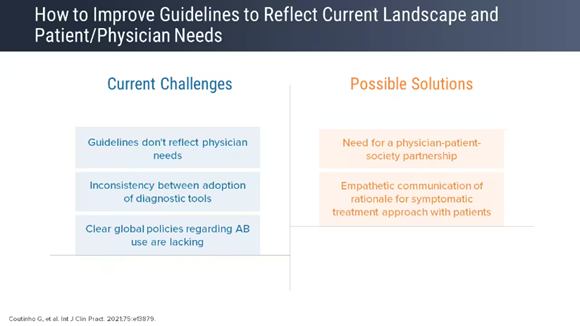
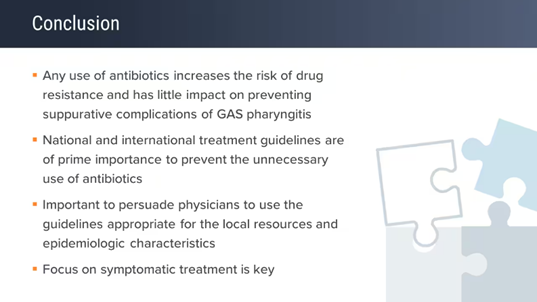
Clearly Auctoresonline and particularly Psychology and Mental Health Care Journal is dedicated to improving health care services for individuals and populations. The editorial boards' ability to efficiently recognize and share the global importance of health literacy with a variety of stakeholders. Auctoresonline publishing platform can be used to facilitate of optimal client-based services and should be added to health care professionals' repertoire of evidence-based health care resources.

Journal of Clinical Cardiology and Cardiovascular Intervention The submission and review process was adequate. However I think that the publication total value should have been enlightened in early fases. Thank you for all.

Journal of Women Health Care and Issues By the present mail, I want to say thank to you and tour colleagues for facilitating my published article. Specially thank you for the peer review process, support from the editorial office. I appreciate positively the quality of your journal.
Journal of Clinical Research and Reports I would be very delighted to submit my testimonial regarding the reviewer board and the editorial office. The reviewer board were accurate and helpful regarding any modifications for my manuscript. And the editorial office were very helpful and supportive in contacting and monitoring with any update and offering help. It was my pleasure to contribute with your promising Journal and I am looking forward for more collaboration.

We would like to thank the Journal of Thoracic Disease and Cardiothoracic Surgery because of the services they provided us for our articles. The peer-review process was done in a very excellent time manner, and the opinions of the reviewers helped us to improve our manuscript further. The editorial office had an outstanding correspondence with us and guided us in many ways. During a hard time of the pandemic that is affecting every one of us tremendously, the editorial office helped us make everything easier for publishing scientific work. Hope for a more scientific relationship with your Journal.

The peer-review process which consisted high quality queries on the paper. I did answer six reviewers’ questions and comments before the paper was accepted. The support from the editorial office is excellent.

Journal of Neuroscience and Neurological Surgery. I had the experience of publishing a research article recently. The whole process was simple from submission to publication. The reviewers made specific and valuable recommendations and corrections that improved the quality of my publication. I strongly recommend this Journal.

Dr. Katarzyna Byczkowska My testimonial covering: "The peer review process is quick and effective. The support from the editorial office is very professional and friendly. Quality of the Clinical Cardiology and Cardiovascular Interventions is scientific and publishes ground-breaking research on cardiology that is useful for other professionals in the field.

Thank you most sincerely, with regard to the support you have given in relation to the reviewing process and the processing of my article entitled "Large Cell Neuroendocrine Carcinoma of The Prostate Gland: A Review and Update" for publication in your esteemed Journal, Journal of Cancer Research and Cellular Therapeutics". The editorial team has been very supportive.

Testimony of Journal of Clinical Otorhinolaryngology: work with your Reviews has been a educational and constructive experience. The editorial office were very helpful and supportive. It was a pleasure to contribute to your Journal.

Dr. Bernard Terkimbi Utoo, I am happy to publish my scientific work in Journal of Women Health Care and Issues (JWHCI). The manuscript submission was seamless and peer review process was top notch. I was amazed that 4 reviewers worked on the manuscript which made it a highly technical, standard and excellent quality paper. I appreciate the format and consideration for the APC as well as the speed of publication. It is my pleasure to continue with this scientific relationship with the esteem JWHCI.

This is an acknowledgment for peer reviewers, editorial board of Journal of Clinical Research and Reports. They show a lot of consideration for us as publishers for our research article “Evaluation of the different factors associated with side effects of COVID-19 vaccination on medical students, Mutah university, Al-Karak, Jordan”, in a very professional and easy way. This journal is one of outstanding medical journal.
Dear Hao Jiang, to Journal of Nutrition and Food Processing We greatly appreciate the efficient, professional and rapid processing of our paper by your team. If there is anything else we should do, please do not hesitate to let us know. On behalf of my co-authors, we would like to express our great appreciation to editor and reviewers.

As an author who has recently published in the journal "Brain and Neurological Disorders". I am delighted to provide a testimonial on the peer review process, editorial office support, and the overall quality of the journal. The peer review process at Brain and Neurological Disorders is rigorous and meticulous, ensuring that only high-quality, evidence-based research is published. The reviewers are experts in their fields, and their comments and suggestions were constructive and helped improve the quality of my manuscript. The review process was timely and efficient, with clear communication from the editorial office at each stage. The support from the editorial office was exceptional throughout the entire process. The editorial staff was responsive, professional, and always willing to help. They provided valuable guidance on formatting, structure, and ethical considerations, making the submission process seamless. Moreover, they kept me informed about the status of my manuscript and provided timely updates, which made the process less stressful. The journal Brain and Neurological Disorders is of the highest quality, with a strong focus on publishing cutting-edge research in the field of neurology. The articles published in this journal are well-researched, rigorously peer-reviewed, and written by experts in the field. The journal maintains high standards, ensuring that readers are provided with the most up-to-date and reliable information on brain and neurological disorders. In conclusion, I had a wonderful experience publishing in Brain and Neurological Disorders. The peer review process was thorough, the editorial office provided exceptional support, and the journal's quality is second to none. I would highly recommend this journal to any researcher working in the field of neurology and brain disorders.

Dear Agrippa Hilda, Journal of Neuroscience and Neurological Surgery, Editorial Coordinator, I trust this message finds you well. I want to extend my appreciation for considering my article for publication in your esteemed journal. I am pleased to provide a testimonial regarding the peer review process and the support received from your editorial office. The peer review process for my paper was carried out in a highly professional and thorough manner. The feedback and comments provided by the authors were constructive and very useful in improving the quality of the manuscript. This rigorous assessment process undoubtedly contributes to the high standards maintained by your journal.

International Journal of Clinical Case Reports and Reviews. I strongly recommend to consider submitting your work to this high-quality journal. The support and availability of the Editorial staff is outstanding and the review process was both efficient and rigorous.

Thank you very much for publishing my Research Article titled “Comparing Treatment Outcome Of Allergic Rhinitis Patients After Using Fluticasone Nasal Spray And Nasal Douching" in the Journal of Clinical Otorhinolaryngology. As Medical Professionals we are immensely benefited from study of various informative Articles and Papers published in this high quality Journal. I look forward to enriching my knowledge by regular study of the Journal and contribute my future work in the field of ENT through the Journal for use by the medical fraternity. The support from the Editorial office was excellent and very prompt. I also welcome the comments received from the readers of my Research Article.

Dear Erica Kelsey, Editorial Coordinator of Cancer Research and Cellular Therapeutics Our team is very satisfied with the processing of our paper by your journal. That was fast, efficient, rigorous, but without unnecessary complications. We appreciated the very short time between the submission of the paper and its publication on line on your site.

I am very glad to say that the peer review process is very successful and fast and support from the Editorial Office. Therefore, I would like to continue our scientific relationship for a long time. And I especially thank you for your kindly attention towards my article. Have a good day!

"We recently published an article entitled “Influence of beta-Cyclodextrins upon the Degradation of Carbofuran Derivatives under Alkaline Conditions" in the Journal of “Pesticides and Biofertilizers” to show that the cyclodextrins protect the carbamates increasing their half-life time in the presence of basic conditions This will be very helpful to understand carbofuran behaviour in the analytical, agro-environmental and food areas. We greatly appreciated the interaction with the editor and the editorial team; we were particularly well accompanied during the course of the revision process, since all various steps towards publication were short and without delay".

I would like to express my gratitude towards you process of article review and submission. I found this to be very fair and expedient. Your follow up has been excellent. I have many publications in national and international journal and your process has been one of the best so far. Keep up the great work.

We are grateful for this opportunity to provide a glowing recommendation to the Journal of Psychiatry and Psychotherapy. We found that the editorial team were very supportive, helpful, kept us abreast of timelines and over all very professional in nature. The peer review process was rigorous, efficient and constructive that really enhanced our article submission. The experience with this journal remains one of our best ever and we look forward to providing future submissions in the near future.

I am very pleased to serve as EBM of the journal, I hope many years of my experience in stem cells can help the journal from one way or another. As we know, stem cells hold great potential for regenerative medicine, which are mostly used to promote the repair response of diseased, dysfunctional or injured tissue using stem cells or their derivatives. I think Stem Cell Research and Therapeutics International is a great platform to publish and share the understanding towards the biology and translational or clinical application of stem cells.

I would like to give my testimony in the support I have got by the peer review process and to support the editorial office where they were of asset to support young author like me to be encouraged to publish their work in your respected journal and globalize and share knowledge across the globe. I really give my great gratitude to your journal and the peer review including the editorial office.

I am delighted to publish our manuscript entitled "A Perspective on Cocaine Induced Stroke - Its Mechanisms and Management" in the Journal of Neuroscience and Neurological Surgery. The peer review process, support from the editorial office, and quality of the journal are excellent. The manuscripts published are of high quality and of excellent scientific value. I recommend this journal very much to colleagues.

Dr.Tania Muñoz, My experience as researcher and author of a review article in The Journal Clinical Cardiology and Interventions has been very enriching and stimulating. The editorial team is excellent, performs its work with absolute responsibility and delivery. They are proactive, dynamic and receptive to all proposals. Supporting at all times the vast universe of authors who choose them as an option for publication. The team of review specialists, members of the editorial board, are brilliant professionals, with remarkable performance in medical research and scientific methodology. Together they form a frontline team that consolidates the JCCI as a magnificent option for the publication and review of high-level medical articles and broad collective interest. I am honored to be able to share my review article and open to receive all your comments.

“The peer review process of JPMHC is quick and effective. Authors are benefited by good and professional reviewers with huge experience in the field of psychology and mental health. The support from the editorial office is very professional. People to contact to are friendly and happy to help and assist any query authors might have. Quality of the Journal is scientific and publishes ground-breaking research on mental health that is useful for other professionals in the field”.

Dear editorial department: On behalf of our team, I hereby certify the reliability and superiority of the International Journal of Clinical Case Reports and Reviews in the peer review process, editorial support, and journal quality. Firstly, the peer review process of the International Journal of Clinical Case Reports and Reviews is rigorous, fair, transparent, fast, and of high quality. The editorial department invites experts from relevant fields as anonymous reviewers to review all submitted manuscripts. These experts have rich academic backgrounds and experience, and can accurately evaluate the academic quality, originality, and suitability of manuscripts. The editorial department is committed to ensuring the rigor of the peer review process, while also making every effort to ensure a fast review cycle to meet the needs of authors and the academic community. Secondly, the editorial team of the International Journal of Clinical Case Reports and Reviews is composed of a group of senior scholars and professionals with rich experience and professional knowledge in related fields. The editorial department is committed to assisting authors in improving their manuscripts, ensuring their academic accuracy, clarity, and completeness. Editors actively collaborate with authors, providing useful suggestions and feedback to promote the improvement and development of the manuscript. We believe that the support of the editorial department is one of the key factors in ensuring the quality of the journal. Finally, the International Journal of Clinical Case Reports and Reviews is renowned for its high- quality articles and strict academic standards. The editorial department is committed to publishing innovative and academically valuable research results to promote the development and progress of related fields. The International Journal of Clinical Case Reports and Reviews is reasonably priced and ensures excellent service and quality ratio, allowing authors to obtain high-level academic publishing opportunities in an affordable manner. I hereby solemnly declare that the International Journal of Clinical Case Reports and Reviews has a high level of credibility and superiority in terms of peer review process, editorial support, reasonable fees, and journal quality. Sincerely, Rui Tao.

Clinical Cardiology and Cardiovascular Interventions I testity the covering of the peer review process, support from the editorial office, and quality of the journal.

Clinical Cardiology and Cardiovascular Interventions, we deeply appreciate the interest shown in our work and its publication. It has been a true pleasure to collaborate with you. The peer review process, as well as the support provided by the editorial office, have been exceptional, and the quality of the journal is very high, which was a determining factor in our decision to publish with you.
The peer reviewers process is quick and effective, the supports from editorial office is excellent, the quality of journal is high. I would like to collabroate with Internatioanl journal of Clinical Case Reports and Reviews journal clinically in the future time.

Clinical Cardiology and Cardiovascular Interventions, I would like to express my sincerest gratitude for the trust placed in our team for the publication in your journal. It has been a true pleasure to collaborate with you on this project. I am pleased to inform you that both the peer review process and the attention from the editorial coordination have been excellent. Your team has worked with dedication and professionalism to ensure that your publication meets the highest standards of quality. We are confident that this collaboration will result in mutual success, and we are eager to see the fruits of this shared effort.

Dear Dr. Jessica Magne, Editorial Coordinator 0f Clinical Cardiology and Cardiovascular Interventions, I hope this message finds you well. I want to express my utmost gratitude for your excellent work and for the dedication and speed in the publication process of my article titled "Navigating Innovation: Qualitative Insights on Using Technology for Health Education in Acute Coronary Syndrome Patients." I am very satisfied with the peer review process, the support from the editorial office, and the quality of the journal. I hope we can maintain our scientific relationship in the long term.
Dear Monica Gissare, - Editorial Coordinator of Nutrition and Food Processing. ¨My testimony with you is truly professional, with a positive response regarding the follow-up of the article and its review, you took into account my qualities and the importance of the topic¨.

Dear Dr. Jessica Magne, Editorial Coordinator 0f Clinical Cardiology and Cardiovascular Interventions, The review process for the article “The Handling of Anti-aggregants and Anticoagulants in the Oncologic Heart Patient Submitted to Surgery” was extremely rigorous and detailed. From the initial submission to the final acceptance, the editorial team at the “Journal of Clinical Cardiology and Cardiovascular Interventions” demonstrated a high level of professionalism and dedication. The reviewers provided constructive and detailed feedback, which was essential for improving the quality of our work. Communication was always clear and efficient, ensuring that all our questions were promptly addressed. The quality of the “Journal of Clinical Cardiology and Cardiovascular Interventions” is undeniable. It is a peer-reviewed, open-access publication dedicated exclusively to disseminating high-quality research in the field of clinical cardiology and cardiovascular interventions. The journal's impact factor is currently under evaluation, and it is indexed in reputable databases, which further reinforces its credibility and relevance in the scientific field. I highly recommend this journal to researchers looking for a reputable platform to publish their studies.

Dear Editorial Coordinator of the Journal of Nutrition and Food Processing! "I would like to thank the Journal of Nutrition and Food Processing for including and publishing my article. The peer review process was very quick, movement and precise. The Editorial Board has done an extremely conscientious job with much help, valuable comments and advices. I find the journal very valuable from a professional point of view, thank you very much for allowing me to be part of it and I would like to participate in the future!”

Dealing with The Journal of Neurology and Neurological Surgery was very smooth and comprehensive. The office staff took time to address my needs and the response from editors and the office was prompt and fair. I certainly hope to publish with this journal again.Their professionalism is apparent and more than satisfactory. Susan Weiner

My Testimonial Covering as fellowing: Lin-Show Chin. The peer reviewers process is quick and effective, the supports from editorial office is excellent, the quality of journal is high. I would like to collabroate with Internatioanl journal of Clinical Case Reports and Reviews.

My experience publishing in Psychology and Mental Health Care was exceptional. The peer review process was rigorous and constructive, with reviewers providing valuable insights that helped enhance the quality of our work. The editorial team was highly supportive and responsive, making the submission process smooth and efficient. The journal's commitment to high standards and academic rigor makes it a respected platform for quality research. I am grateful for the opportunity to publish in such a reputable journal.
My experience publishing in International Journal of Clinical Case Reports and Reviews was exceptional. I Come forth to Provide a Testimonial Covering the Peer Review Process and the editorial office for the Professional and Impartial Evaluation of the Manuscript.

I would like to offer my testimony in the support. I have received through the peer review process and support the editorial office where they are to support young authors like me, encourage them to publish their work in your esteemed journals, and globalize and share knowledge globally. I really appreciate your journal, peer review, and editorial office.
Dear Agrippa Hilda- Editorial Coordinator of Journal of Neuroscience and Neurological Surgery, "The peer review process was very quick and of high quality, which can also be seen in the articles in the journal. The collaboration with the editorial office was very good."

I would like to express my sincere gratitude for the support and efficiency provided by the editorial office throughout the publication process of my article, “Delayed Vulvar Metastases from Rectal Carcinoma: A Case Report.” I greatly appreciate the assistance and guidance I received from your team, which made the entire process smooth and efficient. The peer review process was thorough and constructive, contributing to the overall quality of the final article. I am very grateful for the high level of professionalism and commitment shown by the editorial staff, and I look forward to maintaining a long-term collaboration with the International Journal of Clinical Case Reports and Reviews.
To Dear Erin Aust, I would like to express my heartfelt appreciation for the opportunity to have my work published in this esteemed journal. The entire publication process was smooth and well-organized, and I am extremely satisfied with the final result. The Editorial Team demonstrated the utmost professionalism, providing prompt and insightful feedback throughout the review process. Their clear communication and constructive suggestions were invaluable in enhancing my manuscript, and their meticulous attention to detail and dedication to quality are truly commendable. Additionally, the support from the Editorial Office was exceptional. From the initial submission to the final publication, I was guided through every step of the process with great care and professionalism. The team's responsiveness and assistance made the entire experience both easy and stress-free. I am also deeply impressed by the quality and reputation of the journal. It is an honor to have my research featured in such a respected publication, and I am confident that it will make a meaningful contribution to the field.

"I am grateful for the opportunity of contributing to [International Journal of Clinical Case Reports and Reviews] and for the rigorous review process that enhances the quality of research published in your esteemed journal. I sincerely appreciate the time and effort of your team who have dedicatedly helped me in improvising changes and modifying my manuscript. The insightful comments and constructive feedback provided have been invaluable in refining and strengthening my work".

I thank the ‘Journal of Clinical Research and Reports’ for accepting this article for publication. This is a rigorously peer reviewed journal which is on all major global scientific data bases. I note the review process was prompt, thorough and professionally critical. It gave us an insight into a number of important scientific/statistical issues. The review prompted us to review the relevant literature again and look at the limitations of the study. The peer reviewers were open, clear in the instructions and the editorial team was very prompt in their communication. This journal certainly publishes quality research articles. I would recommend the journal for any future publications.

Dear Jessica Magne, with gratitude for the joint work. Fast process of receiving and processing the submitted scientific materials in “Clinical Cardiology and Cardiovascular Interventions”. High level of competence of the editors with clear and correct recommendations and ideas for enriching the article.

We found the peer review process quick and positive in its input. The support from the editorial officer has been very agile, always with the intention of improving the article and taking into account our subsequent corrections.

My article, titled 'No Way Out of the Smartphone Epidemic Without Considering the Insights of Brain Research,' has been republished in the International Journal of Clinical Case Reports and Reviews. The review process was seamless and professional, with the editors being both friendly and supportive. I am deeply grateful for their efforts.
To Dear Erin Aust – Editorial Coordinator of Journal of General Medicine and Clinical Practice! I declare that I am absolutely satisfied with your work carried out with great competence in following the manuscript during the various stages from its receipt, during the revision process to the final acceptance for publication. Thank Prof. Elvira Farina

Dear Jessica, and the super professional team of the ‘Clinical Cardiology and Cardiovascular Interventions’ I am sincerely grateful to the coordinated work of the journal team for the no problem with the submission of my manuscript: “Cardiometabolic Disorders in A Pregnant Woman with Severe Preeclampsia on the Background of Morbid Obesity (Case Report).” The review process by 5 experts was fast, and the comments were professional, which made it more specific and academic, and the process of publication and presentation of the article was excellent. I recommend that my colleagues publish articles in this journal, and I am interested in further scientific cooperation. Sincerely and best wishes, Dr. Oleg Golyanovskiy.

Dear Ashley Rosa, Editorial Coordinator of the journal - Psychology and Mental Health Care. " The process of obtaining publication of my article in the Psychology and Mental Health Journal was positive in all areas. The peer review process resulted in a number of valuable comments, the editorial process was collaborative and timely, and the quality of this journal has been quickly noticed, resulting in alternative journals contacting me to publish with them." Warm regards, Susan Anne Smith, PhD. Australian Breastfeeding Association.

Dear Jessica Magne, Editorial Coordinator, Clinical Cardiology and Cardiovascular Interventions, Auctores Publishing LLC. I appreciate the journal (JCCI) editorial office support, the entire team leads were always ready to help, not only on technical front but also on thorough process. Also, I should thank dear reviewers’ attention to detail and creative approach to teach me and bring new insights by their comments. Surely, more discussions and introduction of other hemodynamic devices would provide better prevention and management of shock states. Your efforts and dedication in presenting educational materials in this journal are commendable. Best wishes from, Farahnaz Fallahian.
Dear Maria Emerson, Editorial Coordinator, International Journal of Clinical Case Reports and Reviews, Auctores Publishing LLC. I am delighted to have published our manuscript, "Acute Colonic Pseudo-Obstruction (ACPO): A rare but serious complication following caesarean section." I want to thank the editorial team, especially Maria Emerson, for their prompt review of the manuscript, quick responses to queries, and overall support. Yours sincerely Dr. Victor Olagundoye.

Dear Ashley Rosa, Editorial Coordinator, International Journal of Clinical Case Reports and Reviews. Many thanks for publishing this manuscript after I lost confidence the editors were most helpful, more than other journals Best wishes from, Susan Anne Smith, PhD. Australian Breastfeeding Association.

Dear Agrippa Hilda, Editorial Coordinator, Journal of Neuroscience and Neurological Surgery. The entire process including article submission, review, revision, and publication was extremely easy. The journal editor was prompt and helpful, and the reviewers contributed to the quality of the paper. Thank you so much! Eric Nussbaum, MD
Dr Hala Al Shaikh This is to acknowledge that the peer review process for the article ’ A Novel Gnrh1 Gene Mutation in Four Omani Male Siblings, Presentation and Management ’ sent to the International Journal of Clinical Case Reports and Reviews was quick and smooth. The editorial office was prompt with easy communication.

Dear Erin Aust, Editorial Coordinator, Journal of General Medicine and Clinical Practice. We are pleased to share our experience with the “Journal of General Medicine and Clinical Practice”, following the successful publication of our article. The peer review process was thorough and constructive, helping to improve the clarity and quality of the manuscript. We are especially thankful to Ms. Erin Aust, the Editorial Coordinator, for her prompt communication and continuous support throughout the process. Her professionalism ensured a smooth and efficient publication experience. The journal upholds high editorial standards, and we highly recommend it to fellow researchers seeking a credible platform for their work. Best wishes By, Dr. Rakhi Mishra.

Dear Jessica Magne, Editorial Coordinator, Clinical Cardiology and Cardiovascular Interventions, Auctores Publishing LLC. The peer review process of the journal of Clinical Cardiology and Cardiovascular Interventions was excellent and fast, as was the support of the editorial office and the quality of the journal. Kind regards Walter F. Riesen Prof. Dr. Dr. h.c. Walter F. Riesen.

Dear Ashley Rosa, Editorial Coordinator, International Journal of Clinical Case Reports and Reviews, Auctores Publishing LLC. Thank you for publishing our article, Exploring Clozapine's Efficacy in Managing Aggression: A Multiple Single-Case Study in Forensic Psychiatry in the international journal of clinical case reports and reviews. We found the peer review process very professional and efficient. The comments were constructive, and the whole process was efficient. On behalf of the co-authors, I would like to thank you for publishing this article. With regards, Dr. Jelle R. Lettinga.

Dear Clarissa Eric, Editorial Coordinator, Journal of Clinical Case Reports and Studies, I would like to express my deep admiration for the exceptional professionalism demonstrated by your journal. I am thoroughly impressed by the speed of the editorial process, the substantive and insightful reviews, and the meticulous preparation of the manuscript for publication. Additionally, I greatly appreciate the courteous and immediate responses from your editorial office to all my inquiries. Best Regards, Dariusz Ziora

Dear Chrystine Mejia, Editorial Coordinator, Journal of Neurodegeneration and Neurorehabilitation, Auctores Publishing LLC, We would like to thank the editorial team for the smooth and high-quality communication leading up to the publication of our article in the Journal of Neurodegeneration and Neurorehabilitation. The reviewers have extensive knowledge in the field, and their relevant questions helped to add value to our publication. Kind regards, Dr. Ravi Shrivastava.

Dear Clarissa Eric, Editorial Coordinator, Journal of Clinical Case Reports and Studies, Auctores Publishing LLC, USA Office: +1-(302)-520-2644. I would like to express my sincere appreciation for the efficient and professional handling of my case report by the ‘Journal of Clinical Case Reports and Studies’. The peer review process was not only fast but also highly constructive—the reviewers’ comments were clear, relevant, and greatly helped me improve the quality and clarity of my manuscript. I also received excellent support from the editorial office throughout the process. Communication was smooth and timely, and I felt well guided at every stage, from submission to publication. The overall quality and rigor of the journal are truly commendable. I am pleased to have published my work with Journal of Clinical Case Reports and Studies, and I look forward to future opportunities for collaboration. Sincerely, Aline Tollet, UCLouvain.

Dear Ms. Mayra Duenas, Editorial Coordinator, International Journal of Clinical Case Reports and Reviews. “The International Journal of Clinical Case Reports and Reviews represented the “ideal house” to share with the research community a first experience with the use of the Simeox device for speech rehabilitation. High scientific reputation and attractive website communication were first determinants for the selection of this Journal, and the following submission process exceeded expectations: fast but highly professional peer review, great support by the editorial office, elegant graphic layout. Exactly what a dynamic research team - also composed by allied professionals - needs!" From, Chiara Beccaluva, PT - Italy.

Dear Maria Emerson, Editorial Coordinator, we have deeply appreciated the professionalism demonstrated by the International Journal of Clinical Case Reports and Reviews. The reviewers have extensive knowledge of our field and have been very efficient and fast in supporting the process. I am really looking forward to further collaboration. Thanks. Best regards, Dr. Claudio Ligresti